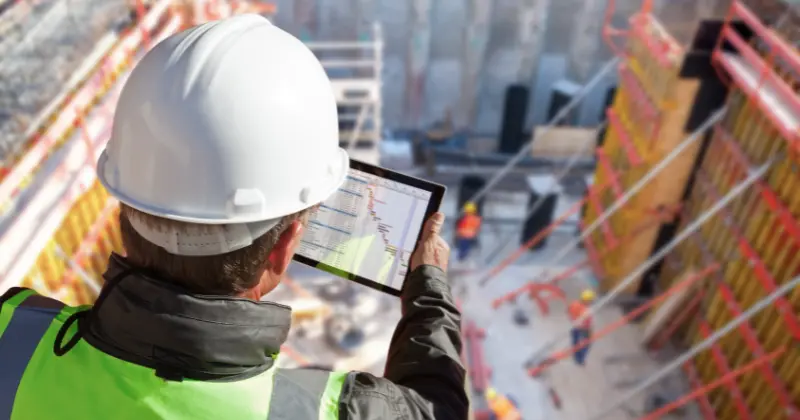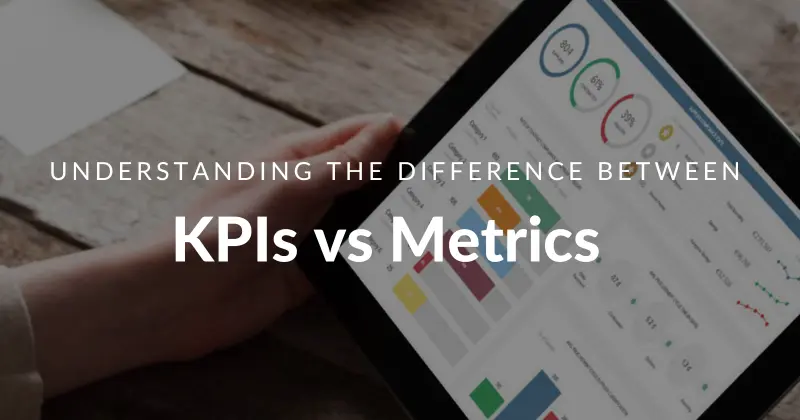11 mins read
The Key To Managing Digital Transformation In Construction

A popular proverb says: “The best time to plant a tree was 20 years ago. The second-best time is now.”
In the context of businesses in the construction and real estate industry today, this means that if you want sustainable growth in the future, the best time to transform is now. The keyword for this transformation is “digital”—the key to the future of all construction.
While the construction industry is undergoing this transformation, many contractors using traditional methods still enjoy success and profit. However, precisely, this success is the biggest obstacle to change and one of the reasons why the industry finds it difficult to engage in change as other industries already have.
If one examines the global construction industry over the past twenty years, one sees that its growth has stagnated compared to other industries. Looking at manufacturing specifically, which was already incredibly optimized, this sector has managed to double its productivity growth over the same period. This presents the construction industry with both a challenge and an opportunity.
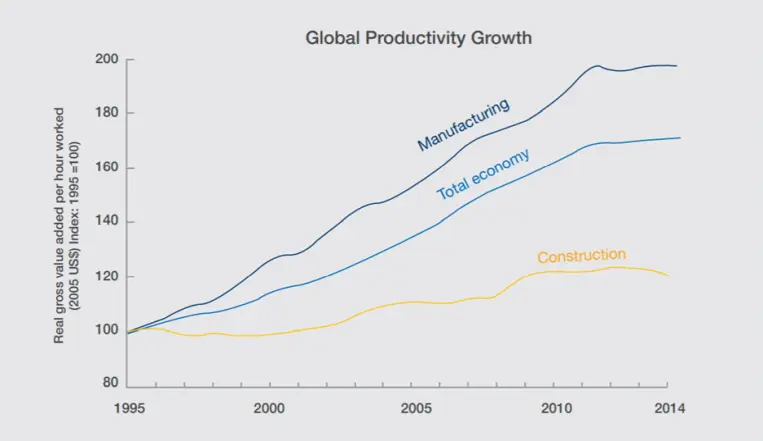
(Source: Fuchs et al., Navigating the Digital Future: The Disruption of Capital Projects, 2017)
It is true that the entire construction industry is currently reshaping itself around technology. However, many construction companies feel intimidated about taking on new digital processes. They might be afraid that the technology will slow them down, add an element of confusion, or cause unnecessary expense.
However, with proper digital transformation management, contractors can vastly improve their processes, which affords them a greater competitive advantage. In this guide, we will uncover some of the reasons why digital transformation is so important in construction and how to overcome digital fears.
What Is Digital Transformation In Construction?
Digital transformation in construction refers to implementing digital processes and technology to make activities once done manually or with traditional methods more efficient. Some technologies used include the cloud, BIM, and IoT sensors.
As mentioned earlier, the industry has demonstrated a reticence to change even with new technologies and processes developing. However, we have reached a point where change is inevitable, and the construction industry needs to keep up with the digital world.
Managing digital transformation in the construction industry involves more than simply introducing new software. It should involve a complete shift in the way businesses operate and approach projects. Taking a digital approach will offer a strong platform for sustained growth within a business. Whether this is through data-enabled hardware, specialized construction management software, or digital tools, this type of transformation will improve traditional construction processes.
The Key Driving Forces Behind Digital Transformation
- According to McKinsey, if construction’s productivity had grown at the same rate as the global economy, the added value would have equated to $1.6 trillion, making economic benefit one of the most powerful driving forces.
- The second reason is linked to two deeply rooted challenges: cost and schedule overruns. The average delay for a construction project is 20 months, with an average cost overrun of 80%. For such a low-margin industry with single-digit percentages, these overruns are extremely problematic but also present the construction industry with the chance to do things differently.
- This industry is also one of the world’s least developed in terms of technology and invests far less in IT than other sectors.
- Several mega-trends also have the potential to profoundly impact the construction sector, including aging infrastructure, population growth outstripping capacity growth, sustainability, changes in the way we engage with the workforce, evolving politics, and regulatory pressures.
While these driving forces are beneficial, they can also intimidate an organization comfortable with its existing system. However, the benefits are undeniable, and if we don’t ‘Uber’ ourselves, we will eventually get ‘Kodaked.’ If we stay where we are and don’t innovate, we will be disrupted by other players, perhaps, for example, by non-traditional construction players from other industries. Corporate cross-over is on the rise, and it is inevitable that with machine learning, AI, and digitalization, corporate players, so far excluded from construction, will seek ways to break into what, up till now has been considered a closed shop.
Why is Digital Transformation Important in Construction?
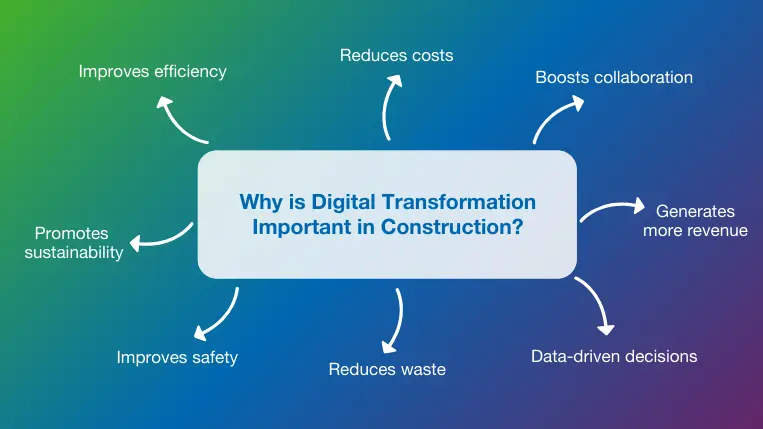
Whether it’s automation for improved productivity and performance, cloud-based software for greater collaboration, or the use of digital construction technology for on-site risk management through off-site manufacturing, digital transformation offers a host of qualitative benefits across the value chain. Most business leaders, however, agree that the biggest advantage will be experienced in project management and performance. Let’s explore the benefits in more detail below!
Improves Efficiency
With automation and cloud-based construction software, all types of businesses and industries can maximize their efficiency. Automation technology can now speed up time-consuming tasks, such as data entry, freeing up more time for more important tasks. Additionally, it helps improve accuracy by eliminating the need to perform manual tasks, preventing the risks of human error.
Reduces Costs
Digitization can help businesses save money by enhancing construction productivity. With the right digital tools, data becomes easier to manage, projects can be completed faster, and certain costly processes can be automated. Technology can also help businesses scale far more easily, cutting down on the significant costs associated with growth.
Boosts Collaboration
The cloud nature of digital construction tools eliminates the everlasting issue of construction collaboration by offering a centralized location to manage all documentation and activities. This ensures team members can work together regardless of location, preventing misunderstandings or errors due to outdated information.
Generates More Revenue
Construction businesses need a digital advantage to access new markets and beat the competition in today’s world. For example, BIM management software allows construction companies to offer their clients a 3D model of the project that allows for the simulation of different activities for efficient cost and time management strategies. This gives the company an added value that can lead to an increase in revenue.
Data-driven Decisions
Digital transformation technologies in construction make managing data and using it to your advantage significantly easier. Modern software offers construction reporting capabilities that allow companies to visualize their data in real-time and eliminate intuition from the decision-making process, making every process more efficient and with almost no errors.
Reduces Waste
Technology like IoT sensors helps track material usage on-site in real time to extract valuable conclusions and adjust to minimize waste. This is an invaluable benefit that saves the project money by avoiding material waste and reducing its environmental impact. Plus, the data extracted can be used for future projects to stay one step ahead of potential waste.
Improves Safety
Another benefit related to sensors and drones is enhanced safety on the building site. The sensors track everything from workers’ movements to environmental hazards, equipment, and more to significantly reduce incident risks and ensure adherence to safety protocols. Just like with material waste, the data extracted from the sensors can be used to predict potential safety risks and mitigate them for future projects.
Promotes Sustainability
Digital technologies help make companies and projects in the building industry more sustainable. 6D BIM technology adds a sustainability layer to the 3D model, allowing for greener designs, better resource allocation, sourcing of sustainable materials, and tracking carbon emissions, among many other things.
Why Do We Resist Digital Transformation? Key Challenges
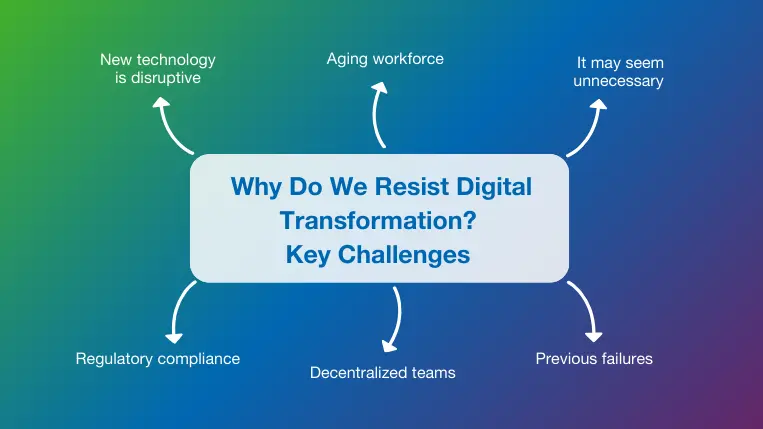
Digital transformation may be an essential part of our future, but many businesses are still holding back. Here are some of the major challenges or reasons why.
New Technology is Disruptive
Implementing digital transformation always leads to disruption. While it may offer many long-term benefits, changing a business’s current processes can be scary and time-consuming. Many construction organizations put off digital transformation to avoid the initial disruption.
If your current system is working, digital transformation may seem unnecessary. However, it’s important to understand that your current systems may become obsolete within the next few years.
To overcome the fear of disruption, you could also choose to partner with the right provider, a company with vast industry-specific knowledge and a successful history of helping companies like yours to manage changes within their organization, like RIB Software.
Aging Workforce
The average construction industry worker is older than other industries. This leads to labor shortage challenges due to retirement and digital adoptions, as older workers are not as tech-savvy and might want to stick to what they already know and work.
In the construction industry, legacy procedures still dominate, and for many, the perception of migrating to a new construction management software seems almost antithetical to “the way things are done.”
However, there is no doubt that within this soon-to-be obsolete paradigm of doing things, frustration with existing project delivery systems and processes can run high in any project. As a result, more and more companies are turning to construction management software and, by proxy, leaner digitalized management systems.
After researching the features and benefits of construction software available on the market and carefully selecting the best one for their business, the next step is to get their people to change their way of working, accept the new software, and finally actually use it.
Adopting new software involves a shift in workflow, thinking, and working methods. Though there is a learning curve, the payoff is well worth the effort.
It May Seem Unnecessary
How do we know digital transformation is worth it? If a business’s systems work right now, why won’t they continue to work in the future? Many might question whether going digital is truly worth it.
While there’s no definitive answer, consider the rapid pace of digital development over the last ten years. Do you want to risk your business falling behind in the future?
Previous Failures
If you’ve tried digital transformation before and failed, it may be off-putting. Understand that there are many ways to digitize your operation and that taking a different approach could result in a vastly different outcome. Learn from your failure and take the risk again with a more informed approach, and you will reap the benefits.
It’s really people working together who create great buildings. Thus, a unique advantage is manifested when bringing together all relevant project stakeholders from the get-go. By getting all brains in the game, we can optimize what we need to do and ensure our success.
Decentralized Teams
The building lifecycle and workflows need to be connected since construction processes are causal by nature. If your teams use different applications for different specific processes and work orders and plans change, the knock-on effect can be lost time, budget overruns, and unforeseen challenges.
While a big benefit of digital transformation in construction is eliminating the issue of decentralized teams, the topic still presents a challenge as the process might add complexity around topics like data quality, access controls, and versioning.
Luckily, this challenge can be eliminated by investing in software that offers collaboration features that keep teams connected across all project stages. Imagine starting in the planning phase with such connectivity with all relevant stakeholders that when a design is changed, changes in quantity takeoff and costs can be seen immediately, or when a project owner suggests changing course, the effect on cost, time, and final outcome can be calculated instantly. This is the power of connectivity.
Regulatory Compliance
Regulatory compliance always challenges construction organizations seeking digital transformation. While the benefits of doing so are quite substantial, adopting digital technologies comes with relevant safety, quality, and data governance responsibilities that companies must follow to ensure they comply with regulations.
For example, data privacy regulations are very strict and are becoming even stricter worldwide. Therefore, companies investing in IoT devices must also invest in robust security systems to ensure their clients’ data remains private and secure.
Providing employees with training in the different rules and regulations associated with digital adoption is also a good practice to ensure that no misuse occurs.
Decoding Digital Transformation In Construction: Tips & Best Practices
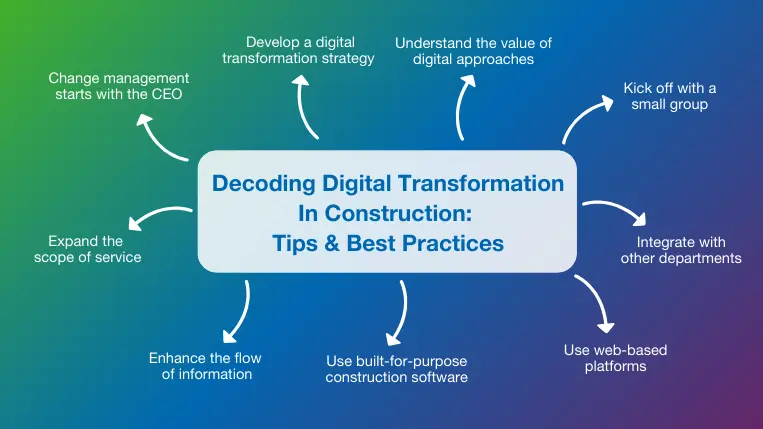
Adopting a new digital approach offers serious benefits. But the shift in processes can be a challenge for many construction businesses.
To ensure you achieve the greatest advantages from adopting new technology, the process needs to be efficient and organized. Let’s discuss some tips and best practices to follow.
1. Change management starts with the CEO
The first step for a successful construction change management process starts with the CEO. It’s very important that the CEO is the person who pushes this through from day one. CEOs must have a vision and understanding of future trends and implicitly anticipate what tomorrow’s clients expect.
Change management is a leadership-driven process where senior management plays a central role in making change successful. If senior management involvement is lacking, team behavior will not change. To make significant changes and shift how employees work, it is critical to ensure that digital transformation is supported by senior management who have the appropriate allocations of budget, human resources, and time available to achieve this transformation. This can only happen with the vision and blessing of the CEO.
2. Develop a digital transformation strategy
Once the digitalization commitment runs from top to bottom, senior management can establish a clear vision for the change management and digital transformation process to take place.
They must be able to clearly define expectations such as:
- How will the company benefit from digital transformation?
- What type of construction management software is needed to support digitalization?
- What result do we expect from digital transformation?
- What strategies should we implement? Project level or enterprise level?
- What does the milestone look like?
3. Understand the value of digital approaches
One key to managing digital transformation in construction is ensuring that everyone understands its value to the business. People will soon revert to old systems if they do not understand the benefits of adopting a new digital approach.
Going digital will not only help you achieve better results but also streamline your work. It makes many processes faster and easier, allowing you to use your time more effectively.
Having everybody on the team on the same page will help drive digital transformation. Therefore, we suggest open communication about upcoming changes and their benefits.
4. Kick off with a small group
“How do you eat an elephant? One bite at a time!”
Digital transformation is a big deal and so implementing change throughout the entire organization can be challenging. This is especially true when over half of employees have never worked with construction management software before.
That’s why starting with ‘smaller pieces’ can be a more practical method. Thus, the first step for many contractors could be to start digitalization within their design or planning teams to develop the working methods, workflows, and standards, that other departments, such as estimate, construction procurement, and business partner management, will inevitably work with, pushing it down the line to these other teams.
5. Integrate with other departments
After the design or planning department is digitalized, the next step is to integrate more departments into the BIM model-based workflows, such as cost estimation, procurement, and site teams. In the end, you’ll have one company that is completely digitally integrated, with standardized workflows and connected data for enterprise-wide projects.
6. Use web-based platforms
Construction and engineering industries work with an incredible amount of data. Transferring information between people can slow processes down during a project. Adopting web-based platforms helps construction businesses to stay up to date with real-time analysis. Cloud-based software offers global access so that users can contribute and access data at anytime from anywhere.
Using a fully integrated software solution helps to eliminate departmental silos and maximize workflows. This type of software can help to make all areas of construction management easier. It facilitates better, more effective collaboration and communication in construction projects.
7. Use built-for-purpose construction software
It’s time to ditch Excel spreadsheets and start using fit-for-purpose construction software. These solutions give you all the information you need in a centralized location to help you enhance your work processes and operations.
Using built-for-purpose software allows you to:
- More easily align your internal processes to industry best practices
- Remove the risk of human error
- Speed up processes
- And improve the accuracy of your results
At RIB Software, we offer a complete toolkit of solutions specific to the construction industry. For example, RIB Candy is our solution for estimating, with features that allow you to plan accurately and efficiently; RIB CostX is a BIM takeoff solution that eliminates the need for manual calculations, enhancing accuracy and eliminating the risk of errors; RIB SpecLink is our platform to manage construction specifications in a single location with collaboration and accessibility.
8. Enhance the flow of information
A common challenge in construction is the flow of information during a project. There are various levels in the system, with data passing between many different people. Managing construction digital transformation effectively means improving this information flow for more seamless processes.
Digital tools can offer work-in-progress data that everyone can view and share. Taking digital approaches allows everyone to communicate better and stay up to date with construction plans. This can help eliminate bottlenecks and avoid project delays due to ineffective communication.
9. Expand the scope of service
The building environment is changing fast, and so is business development. To respond rapidly and flexibly to market demands, business models and the business scope should evolve concurrently, for instance, by adding new divisions such as prefabrication.
Companies in the building environment need to use technology to their advantage if they want to stand out from their competitors. The journey of digital transformation does not stop with adoption; it is a process that must evolve and grow with time to meet the industry’s demands.
Conclusion
Digitalization is the way forward in the construction industry. Organizations need to remove the fear factor from digital transformation if they want to keep up with the world’s changing direction. We shouldn’t see technology as a source of fear but rather embrace its many obvious benefits. By implementing technology in a steady, agile manner, businesses can reap the rewards of digital transformation for construction without facing too much disruption.
For effective digitalization, use the right software and digital tools and follow the correct process for adopting a new digital-focused approach. The correct adoption of these solutions can provide a significant competitive advantage in this changing landscape.
The key to long-term construction digital transformation success is to adopt an enterprise-level platform as the digital foundation that retains an open API for the wider supply chain to adapt to future changes. This way, as the organization evolves, additional solutions can be integrated and interconnected onto this platform, while costly stopgap measures that only help in the short term can be phased out.
At RIB Software, we are leading providers of digital construction software solutions for all project areas, including specifications, estimating, takeoff, planning, carbon tracking, and overall project management. If you are ready to benefit from state-of-the-art digital solutions tailored to the needs of construction companies, get a demo of RIB’s product toolkit today!
Most Recent
11 mins read
10 mins read
10 mins read
29 mins read
Blog Categories

Ebook








